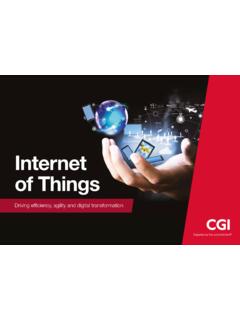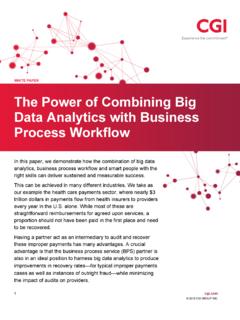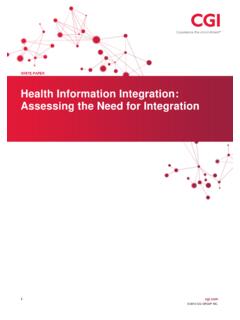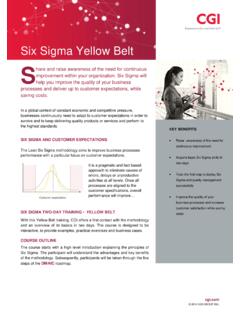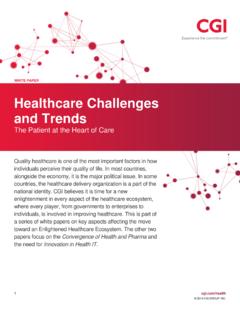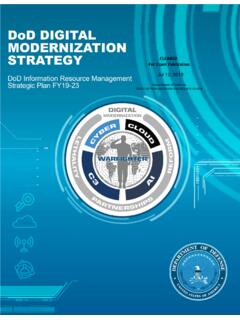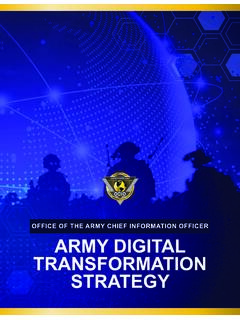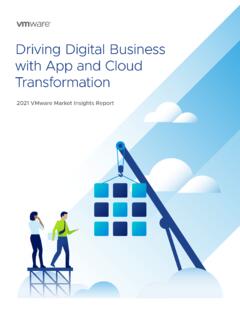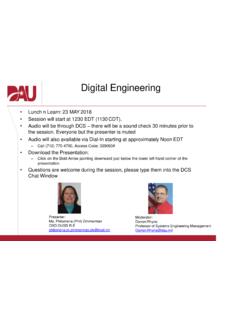Transcription of Digital Transformation in the Manufacturing Industry
1 Digital Transformation in the Manufacturing Industry Table of Contents Introduction 03. Manufacturers are on the threshold of a new Digital era 04. A digitally-integrated and intelligent value chain is vital to drive 06. innovation and become customer-centric The rise of Industry platforms 08. Discrete Digital implementations will require enterprise-grade 10. service levels IT modernization will fuel Digital Transformation 12. Data and analytics is power in the Digital world. But what about 13. master data? The importance of change leadership 14. Accelerating the journey: key takeaways 15. 2 Point of view: Digital Transformation in the Manufacturing Industry Introduction This paper sets out to explore the current challenges of the Manufacturing Industry , with particular emphasis on the effects of digitalization on its processes.
2 The paper builds on the 2016. edition of CGI Global 1000, an outlook based on in-depth, in- person conversations with over 1,000 senior business and IT. leaders, and provides insights and recommendations garnered from CGI's extensive knowledge and experience helping our clients in the Manufacturing Industry increase productivity and agility to transform and grow. About the CGI Global 1000. In 2016, as part of our annual Voice of Clients program, CGI met face-to-face with more than 1,000 business and IT leaders across 10 industries and 20 countries to hear their perspectives on the trends impacting their organizations and the implications these trends have on their business. From the Manufacturing Industry , we interviewed 87 clients across 13 countries and multiple industries including mining, metal, pulp & paper, chemicals, automotive, aerospace, high-tech, industrial and products.
3 Point of view: Digital Transformation in the Manufacturing Industry 3. Manufacturers are on the threshold of a new Digital era As manufacturers embark on their journey to Industry , they are accelerating Digital to optimize, modernize and automate. Digital Transformation is accelerating across the value chain Reducing costs, improving agility and speed to market are the key business drivers IoT, mobile and cloud solutions are essential for the Transformation IT/Legacy modernization is a key enabler Source: CGI Voice of Our Clients (2016). 36% 62%. Almost 90%. of our clients have are exploring Digital initiatives or running are executing Digital pilots and programs, proof of concepts however most are on-going Digital discrete Digital initiatives, although projects they are at different stages in their Transformation journeys.
4 4 Point of view: Digital Transformation in the Manufacturing Industry The question for our clients today isn't whether or not to get on the Digital bandwagon, but how to embrace this Transformation in a smart way that brings together their short-term and discrete on-going initiatives with the prerequisites for a long-term vision, governance and architecture. This paper will share insights and recommendations on the somewhat disparate, but important elements that manufacturers need to consider when planning a Digital strategy and implementing comprehensive solutions to support their strategy. Point of view: Digital Transformation in the Manufacturing Industry 5. A digitally-integrated and intelligent value chain is vital to drive innovation and become customer-centric The CGI Global 1000 outlook reveals the specific drivers of Digital Transformation in the Manufacturing Industry : Currently, there is still a strong focus on product Transformation from product-centric to services and solutions as well as on operations efficiency With the exception perhaps of the Automotive Industry , the focus on consumerization is slightly lower in the Manufacturing Industry compared to other more consumer-oriented sectors like banking and retail.
5 Consumer and customer-centric initiatives in the Manufacturing Industry are very often product driven and leverage systems and methods such as advanced product configurators and mass customization. Technology modernization is of particular importance as the Industry has to often contend with three kinds of legacies R&D, operations and enterprise Along with the three pillars of Industry operations, product lifecycle and value chain Digital Transformation in the Manufacturing Industry boils down to three areas that are tied together in an ubiquitous (cloud- and mobile- enabled), automated (software defined) and secure way. Intelligent and Intelligent and Intelligent and connected assets: for connected products: connected value Chains: top-to-bottom integration aimed at adding value to for collaboration and of operations services and solutions innovation within the eco-system of customers, suppliers and partners 6 Point of view: Digital Transformation in the Manufacturing Industry Manufacturing companies need to consider these Transformation areas and articulate (or re-articulate) what value they bring to their business in terms of client value and differentiation, new business models and growth potential, and prioritize accordingly.
6 Point of view: Digital Transformation in the Manufacturing Industry 7. The rise of Industry platforms The ability to leverage platforms that focus on reuse and commonality, such as modular design systems or, in IT, ERP platforms, is deeply rooted in the Manufacturing Industry . As manufacturers seek to embrace an enterprise- wide approach to Digital Transformation , the various discrete Digital implementations currently in play many of which are based on diverse technologies and niche solutions will consolidate onto packaged Digital platforms. These platforms will likely be Industry specific and will focus on industrial equipment and consumer products such as home appliances, connected cars, etc. They will take advantage of the global reach, cost benefits and opportunities for innovation that large cloud providers such as AWS, MS Azure and Google offer.
7 As the emphasis on innovation in products and services grows, these platforms will also need to handle and integrate product and asset-related information over the various stages of the life cycle, from design, production and sales to service and retirement. Product Lifecycle Management (PLM), Manufacturing information systems and IoT will come together, leveraging connectivity to cover parts of the product or asset life cycle that have so far been overlooked. This development will lie at the heart of the convergence of Digital platforms in the Manufacturing Industry . For affordability reasons, Digital solutions for connected products and connected assets will converge within most manufacturers (across Development, Production and Maintenance / Services business scenarios). 8 Point of view: Digital Transformation in the Manufacturing Industry The ability to seamlessly integrate Development, Production and Maintenance & Services business scenarios should be a key consideration in the selection of Digital solutions and platforms for manufacturers.
8 Among the 300+. Digital and IoT platforms available in the market, the few that support this convergence will be the ones that stand out from the crowd. In addition, manufacturers should consider the platforms' capability to support open standards and Industry frameworks emerging from various Industry alliances such as Allseen, Thread, Open Interconnect Consortium (OIC), Industrial Internet Consortium (IIC) and oneM2M. This should be factored in by manufacturers when developing their Digital strategy and choosing supporting technologies to guarantee future-proof capabilities and consolidate existing diverse initiatives. Point of view: Digital Transformation in the Manufacturing Industry 9. Discrete Digital implementations will require enterprise-grade service levels Most Digital solutions are either business critical (connected assets) and/or client-facing solutions implemented at manufacturers' clients' sites (connected products).
9 A large number of discrete Digital implementations today are point solutions that have been implemented by individual business units in the company. Sometimes provided as-a-Service , these discrete projects do not take into account (at least not at the beginning) integrating the solution with the rest of the company's portfolio of technologies and IT delivery services (Dev-Ops). Critical and/or client-facing solutions require high availability and secure technology. Manufacturers need to keep in mind that the overall reliability of a solution often depends on its weakest component. Right from the beginning, manufacturers need to take a holistic view on the future operability of their Digital solutions. Strong Software and Applications Lifecycle Management (S&ALM) capabilities will also be required to deploy, update and operate innovative solutions involving a large number of intelligent assets, equipment, devices, appliances, buildings or vehicles.
10 Managing software in an industrialized way has so far not necessarily been a priority for manufacturers. This is changing. The ability to manage software is becoming a core element in their Digital transformations, and organizations will need to either acquire these competences or rely on partners for them. Additionally, manufacturers should also look for strong S&ALM capabilities in the platforms that they ultimately choose as the backbone of their Digital initiative. We often hear from our clients the terms of Mode 1 / Mode 2 and traditional vs agile IT . The emergence of a 2-speed IT is a clear outcome of the CGI Global 1000 survey. This means that the IT organization often manages and runs enterprise and traditional IT environments and projects in parallel, and often separated from, Digital and agile initiatives initiated in different business units in the organization, aiming to support their fast changing business needs.
